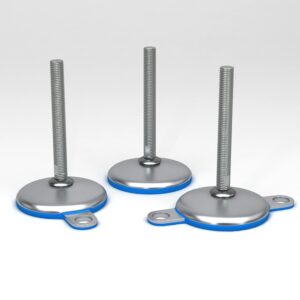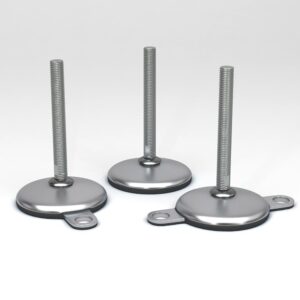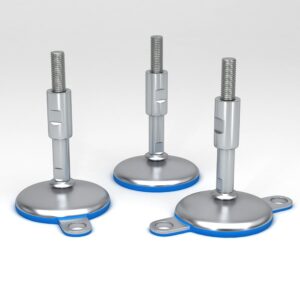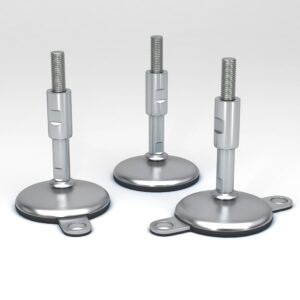Hygienic machine leveling feet are more than just functional
They are a vital part of maintaining a safe, clean, and compliant production process.
Explores the importance of hygienic machine leveling feet, their benefits, and the considerations that must be taken when selecting the right leveling feet for specific applications.
What Are Hygienic Machine Leveling Feet?
Machine leveling feet are adjustable supports designed to stabilize machinery, ensuring that equipment remains level and functions efficiently. While standard leveling feet are sufficient for general industrial use, hygienic machine leveling feet are specifically engineered to meet strict hygiene standards, typically required in industries where contamination can compromise product safety.
Hygienic leveling feet feature smooth surfaces, no gaps or cavities where dirt or bacteria can accumulate, and materials that can withstand frequent washdowns with aggressive cleaning agents. Their design facilitates easy and thorough cleaning, reducing the risk of contamination and ensuring compliance with hygiene regulations such as EHEDG (European Hygienic Engineering and Design Group) and 3-A sanitary standards.
Importance of Hygienic Design in Machine Components
In environments where hygiene is a top priority, like food and beverage processing, pharmaceutical production, and healthcare, maintaining cleanliness is critical to product safety and quality. Machine components that are difficult to clean or that harbor contaminants pose a significant risk.
Hygienic machine leveling feet are a vital part of hygienic design. Their features ensure that dirt, dust, and microorganisms do not accumulate, which helps prevent contamination, the spread of bacteria, and potential product recalls. Furthermore, with more stringent regulations globally, having hygienically designed equipment, including leveling feet, helps manufacturers meet legal compliance and safeguard their brand reputation.
Key Features of Hygienic Machine Leveling Feet
The primary objective of hygienic machine leveling feet is to maintain a clean and safe operating environment. To achieve this, manufacturers incorporate several essential design elements:
- Smooth Surface Finish: One of the most distinguishing features of hygienic leveling feet is their smooth surface, which prevents dirt from adhering. Polished stainless steel is often used to ensure that contaminants do not stick to the surface, and any residues are easily cleaned during washdowns.
- Non-Absorbent Materials: Hygienic leveling feet are typically made from non-porous, non-absorbent materials like stainless steel, which resists corrosion and prevents bacteria from infiltrating the material. This ensures that the feet remain hygienic, even after prolonged exposure to moisture and cleaning chemicals.
- Easy Adjustability and Stability: Adjustable machine leveling feet allow machinery to be precisely leveled, even on uneven surfaces. The feet are designed to be robust and resistant to vibrations, ensuring that the equipment remains stable even during high-intensity operations.
- Sealed Joints and Threads: Traditional leveling feet often have gaps and joints that can trap dirt and moisture. Hygienic machine leveling feet eliminate these issues with sealed designs, ensuring that no bacteria or debris can get trapped in the joints or threads.
- Resistance to Harsh Cleaning Agents: In industries requiring strict hygiene, equipment undergoes regular washdowns with strong cleaning agents like acids, alkalis, and detergents. Hygienic leveling feet are built to withstand such harsh chemicals without corroding or degrading over time.
Applications of Hygienic Machine Leveling Feet
Hygienic machine leveling feet are critical in industries where cleanliness and safety are non-negotiable. Here are a few sectors where these specialized components are widely used:
- Food Processing and Beverage Manufacturing: From dairy products to beverages, food and drink production demands equipment that meets the highest hygiene standards. Hygienic machine leveling feet help prevent contamination in high-risk areas such as mixing tanks, conveyors, and packaging lines.
- Pharmaceutical Industry: In the pharmaceutical industry, where sterility is vital, hygienic machine leveling feet ensure that manufacturing and packaging equipment stays clean and stable. This contributes to the production of contamination-free products, reducing the risk of compromised batches.
- Cosmetic Manufacturing: Similar to pharmaceuticals, cosmetics manufacturing requires strict hygiene standards to ensure that products are safe for consumers. Hygienic machine leveling feet are an integral part of equipment used in cosmetic production lines, helping maintain cleanliness.
- Healthcare Equipment: In hospitals and healthcare facilities, machinery and equipment must be easy to clean and maintain. Hygienic leveling feet ensure that medical devices, diagnostic equipment, and laboratory machinery remain stable and sanitary.
Choosing the Right Hygienic Machine Leveling Feet
When selecting hygienic machine leveling feet, there are several factors to consider:
- Material: Stainless steel is the material of choice due to its durability, resistance to corrosion, and non-absorbent properties. Look for components made from high-grade stainless steel to ensure longevity and ease of cleaning.
- Certifications: Ensure that the leveling feet meet relevant industry standards such as EHEDG and 3-A. These certifications guarantee that the components are designed to minimize contamination risks.
- Adjustability: Depending on the equipment and the environment, the leveling feet should offer the necessary adjustability to keep machines stable, even on uneven floors.
- Environmental Resistance: Consider the cleaning agents and conditions in your facility. Choose leveling feet that can withstand exposure to chemicals, moisture, and high-pressure washdowns without compromising hygiene.
Benefits of Hygienic Machine Leveling Feet
By incorporating hygienic machine leveling feet into your equipment setup, you enjoy several key benefits:
- Improved Cleanability: Hygienic design reduces cleaning time and effort, allowing for more thorough sanitation.
- Reduced Risk of Contamination: The smooth, sealed surfaces prevent the buildup of contaminants, reducing the risk of bacteria spread.
- Increased Compliance: Using components that meet industry standards helps manufacturers comply with hygiene regulations.
- Long-Term Durability: Stainless steel construction ensures that the leveling feet resist corrosion, even in harsh environments.
Hygienic machine leveling feet ensuring stability and cleanliness
In industries where hygiene is critical, machine leveling feet play a key role in ensuring both stability and cleanliness. By investing in hygienic machine leveling feet, manufacturers can meet stringent hygiene standards, reduce contamination risks, and ensure product safety. With their smooth surfaces, corrosion-resistant materials, and easy adjustability, these feet are essential components in environments that demand the highest levels of cleanliness and sanitation.
Questions and contact
Do you have any questions about our products? You are always welcome to contact us for questions about performance and solutions for your machine or anything else. You can read more about how to contact us here. You can find us in Denmark, the UK, Germany and Hong Kong.



